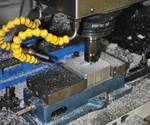The Momentum Behind Aluminum Tooling
A growing number of OEMs are looking to aluminum production molds in order to reduce tooling costs and speed new product time to market. Opportunities exist for shops poised to manufacture such nonferrous tooling.
For years, moldmakers have created “soft” aluminum molds for customers wanting plastic prototypes molded in a design’s specified material or one that closely resembles it. They’ve also produced aluminum bridge tooling to serve as a stopgap measure that enables molders to start limited production while a permanent steel tool is designed and built.
These days, there is a trend toward using aluminum molds for production applications. So opportunities exist for shops that are equipped to effectively create aluminum tooling and have the gumption to go after that type of work. Phoenix Proto Technologies is one such company (a link to a story about this shop is found to the right). In fact, the company exclusively produces aluminum molds and delivers them in three weeks or less without limiting its customers’ part designs to simplify the moldmaking process.
Robert Lammon, Phoenix Proto Technologies’ director of sales, says a growing number of OEMs are considering aluminum production molds as a means to reduce tooling costs, improve profitability and speed time to market for their new products. Mr. Lammon believes aluminum tooling can offer a cost savings of 40 percent versus a comparable steel mold (and that’s a conservative estimate). He says aluminum tooling can be produced 40 percent faster, too.
In addition, using aluminum tooling for injection molding speeds cycle times because the nonferrous material’s thermal conductivity is much greater than steel’s. That makes it possible to bring a tool up to heat and back down faster. Plus, aluminum molds are not as finicky as their steel brethren when it comes to the position of waterlines and jackets for part cooling. New aluminum alloys are better suited to stand up to the rigors of relatively high-volume production as well. And hard-coating offers a way to boost wear resistance of aluminum components that contact each other.
What’s really driving this trend is the definition of “production.” It’s changing. Because OEMs want to introduce new products more frequently, requisite part volumes are not as high as they once were for some applications. A mold that can deliver 1 million shots may be sufficient to satisfy an injection molding production run. When properly designed and machined, aluminum molds can achieve this level of production, Mr. Lammon notes.
Certainly not all applications are suited for aluminum tooling, especially those that require abrasive resins or still have multimillion-shot requirements. However, many suitable applications are out there. That’s why this is a trend worth following.
Related Content
-
Twin Spindle Design Doubles Production of Small Parts
After experiencing process stalls in the finishing stage of production, Bryan Machine Service designed an air-powered twin spindle and indexable rotating base to effectively double its production of small parts.
-
Best Practices: Machining Difficult Materials
Cutting hardened steel, titanium and other difficult materials requires picking the right tools, eliminating spindle runout and relying on best practices to achieve tight part tolerances.
-
For This Machine Shop, Licensing Is the Answer to the Inventor’s Dilemma
Machine shops are natural inventors, but not necessarily suited to supporting and marketing a product. This Minnesota shop with an invention related to micromolding will share it through licensing.

.jpg;width=70;height=70;mode=crop)






.png;maxWidth=300;quality=90)




